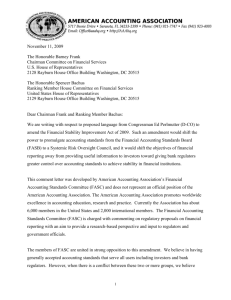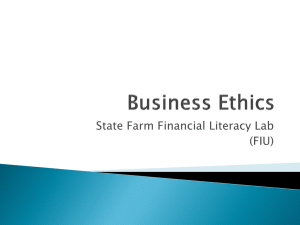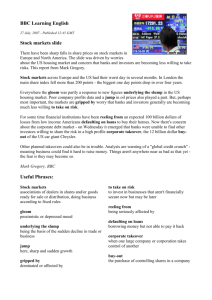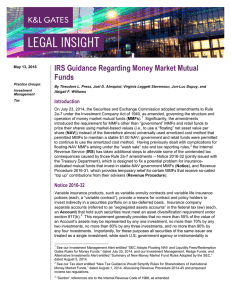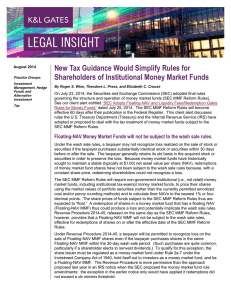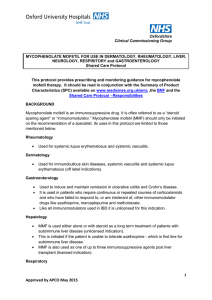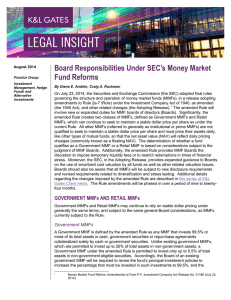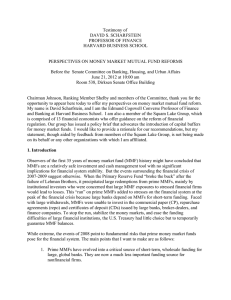How did we get here? - Institutional Money Market Funds Association
advertisement
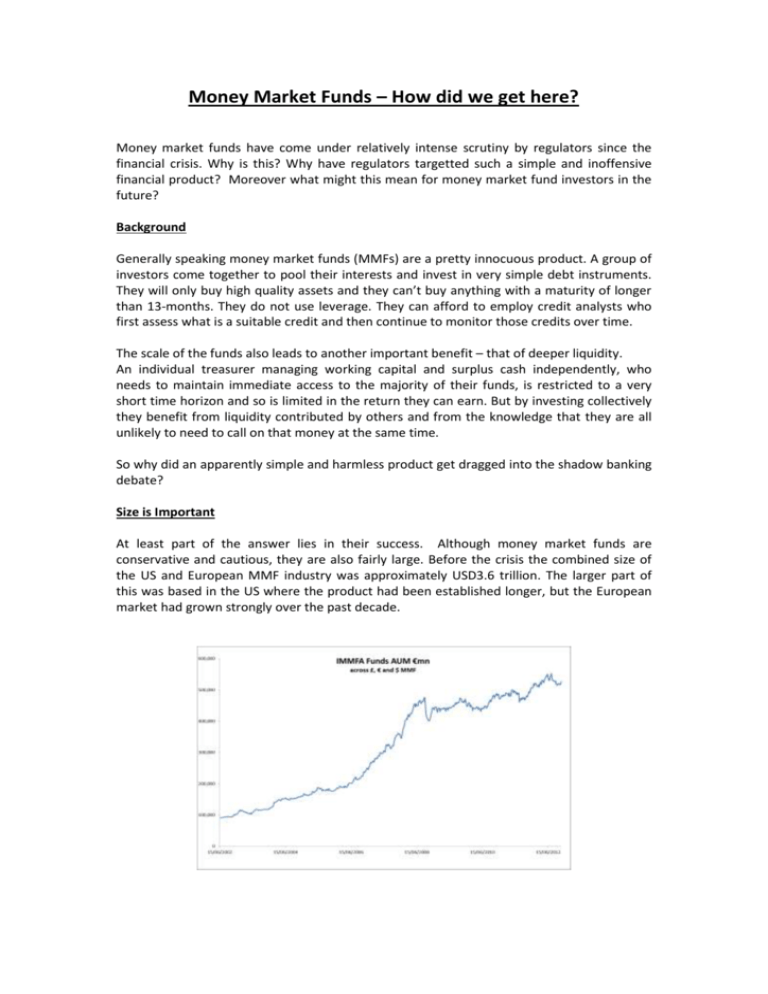
Money Market Funds – How did we get here? Money market funds have come under relatively intense scrutiny by regulators since the financial crisis. Why is this? Why have regulators targetted such a simple and inoffensive financial product? Moreover what might this mean for money market fund investors in the future? Background Generally speaking money market funds (MMFs) are a pretty innocuous product. A group of investors come together to pool their interests and invest in very simple debt instruments. They will only buy high quality assets and they can’t buy anything with a maturity of longer than 13-months. They do not use leverage. They can afford to employ credit analysts who first assess what is a suitable credit and then continue to monitor those credits over time. The scale of the funds also leads to another important benefit – that of deeper liquidity. An individual treasurer managing working capital and surplus cash independently, who needs to maintain immediate access to the majority of their funds, is restricted to a very short time horizon and so is limited in the return they can earn. But by investing collectively they benefit from liquidity contributed by others and from the knowledge that they are all unlikely to need to call on that money at the same time. So why did an apparently simple and harmless product get dragged into the shadow banking debate? Size is Important At least part of the answer lies in their success. Although money market funds are conservative and cautious, they are also fairly large. Before the crisis the combined size of the US and European MMF industry was approximately USD3.6 trillion. The larger part of this was based in the US where the product had been established longer, but the European market had grown strongly over the past decade. The crisis has impacted MMF investors in 2 significant ways. Treasurers’ experience of what happened to some banks (but not to others) has highlighted why it is a good idea to have your risk spread over perhaps 50 largely uncorrelated credits rather than deposited with 5 banks all of whom know each other. Secondly, following the crisis, a corporate’s confidence to be able to borrow cash at short notice; either directly from the capital markets or via a loan or extended overdraft from a bank is much reduced. All sorts of commercial enterprise are carrying more cash. And it all needs to be stored somewhere – ideally not all on deposit, exposed to single-name bank risk. So the demand for MMFs in Europe is even higher now than it was pre-crisis. A Victim of its Own Success Following the crisis regulators are quite reasonably trying to work out what changes would have prevented the catastrophic chain of events which mean that more than 5 years later much of the developed world is struggling with low growth and colossal government debt. Regulators agree that money market funds in no way caused the crisis. However it could be argued that the desire to harness a portion of the cash invested in MMF contributed, along with other oversights and supervisory short-comings, to some behaviour which ultimately led to the global melt down. What concerns the regulators is the sheer scale of money market funds. What happens to the institutions MMF’s are invested in if the fund decides, for whatever reason and no matter how reasonably, to withdraw their funding? They also worry about the links between money market funds and the banking system. For example, many sponsors of money market funds are banks. The regulators see a parallel with the obligations the banks (and their supervisors) suddenly found they had in relation to their ABCP conduits and SIVs. They seem to forget that those were largely contractual undertakings to provide liquidity whereas money market funds are stand-alone mutual funds. Furthermore, many MMF invest in short-term bank debt, though to much less of an extent than has been suggested previously. A recent Fitch report stated that on average European banks rely on European CNAV MMF for approximately 1% of their deposits and short-term funding. IMMFA would argue that many of these specific concerns regarding the interrelation between banks and money market funds would be better addressed directly in banking legislation than by putting restrictions on money market funds. Stronger Money Market Funds The money market fund industry has been keen to build in additional protection to ensure that they are better prepared for any future market disruption. In Europe, the ESMA guidelines were introduced with the aim of harmonising MMF’s into two defined risk categories. However many asset-management firms in Europe believed that this didn’t go far enough. In the US, the 2a-7 rule which determines how US MMF operate introduced changes in 2011 which were more comprehensive – specifying tighter credit limits for a fund and the minimum levels of liquidity which a fund needs to maintain for example. These changes are aimed at making a fund more self-contained – less dependent on the market should conditions become difficult - whilst still being able to repay investors when they want to take money out. IMMFA funds all meet the ESMA guidelines for short-term money market funds. In addition, they voluntarily adhere to the IMMFA Code of Practice which in many ways is similar to the rule 2a-7. So what next? Many regulatory and supervisory bodies have joined the debate over the future of money market fund regulation – with varying degrees of consultation, and with varying degrees of understanding. Here in Europe, the European Commission will propose new legislation for money market funds and by the time you read this article they already may have done so. This then has to be agreed by the European Parliament (the MEPs) and the Council of Ministers (representatives of each member state). In all probability the European Commission has already consulted with the various bodies in order to produce language which is likely to be accepted. The US is working independently to propose new MMF legislation. Although having solutions which are aligned may be beneficial for the money market fund industry and its investors, there is no guarantee that the same or similar solutions will be proposed. Possible Solutions: Various proposals for further MMF reform have been discussed: Prescribed Liquidity Specifying the amount of assets which will mature in certain timeframes – currently ‘next day’ and ‘within 1 week’ intervals are used. This is already used in the US and voluntarily in Europe by IMMFA funds – welcomed and likely to be adopted more widely. Enhanced Disclosure, Enhanced Reporting Increased transparency is widely viewed as desirable. Enhanced reporting should ensure that the regulatory authorities are more aware of what happens in money market funds and should be a positive development. However few regulators believe that this would be a sufficient remedy. Capital Buffers An amount of capital to be held by fund to make good any losses in the fund – at the levels which are rumoured to be being considered (around 3%) would render money market funds uneconomic to providers and/or users. Know Your Client A fund is much less vulnerable if there is a lower likelihood of a large number of investors needing to withdraw funds at the same time. Funds should aim for a more diverse investor base as well as a diverse asset base. This doesn’t seem to be viewed as a priority by regulators currently. CNAV and VNAV The most bitter part of the debate. ‘Constant Net Asset Value’ (CNAV) and ‘Variable Net Asset Value’ (VNAV) are different ways of representing the price of shares in a fund and amount largely to a technical accounting difference. Regulators have formed the impression that investors are more likely to flee from a CNAV fund than from a VNAV fund in a stressed market. CNAV providers argue that investors are sensitive to the risk being carried in a fund – not its accounting technique. A mandatory conversion from CNAV to VNAV would be an accounting and operational inconvenience to many investors and in some cases would make MMF unusable. Moreover it would not have changed the systemic risk profile. Redemption Gates and/or Liquidity Fees These features are already present in many of the CNAV MMF offered in Europe. IMMFA believes they are the most effective way of dampening volatility in a stressed market situation, by enabling the manager to perform its fiduciary responsibility. Conclusion Investors have realised that it often makes sense to store cash in funds where they benefit from a widely diversified portfolio, expert credit analysis and pooled liquidity. Despite the best efforts of many market participants to explain the short-comings of some of the more potentially disruptive regulatory proposals, it is likely that changes will be made which will impact investors. We encourage all MMF investors to familiarize themselves with the issues and to make their voices heard if they wish to be part of the debate, via the ACT, IMMFA, through your MMF providers or directly with your MEPs, HMT etc. It is not too late to influence the outcome of this debate. IMMFA will be hosting a session at the ACT Conference in Liverpool when we will be able to update you on the latest state of these discussions.

